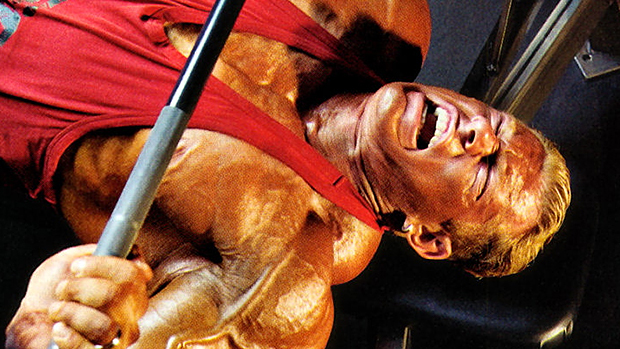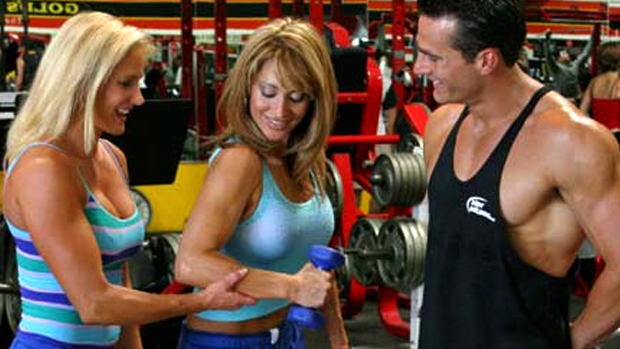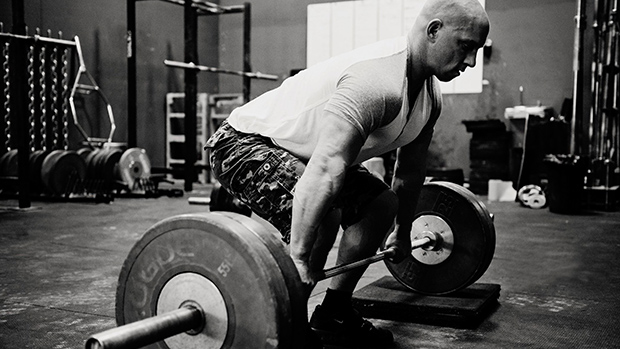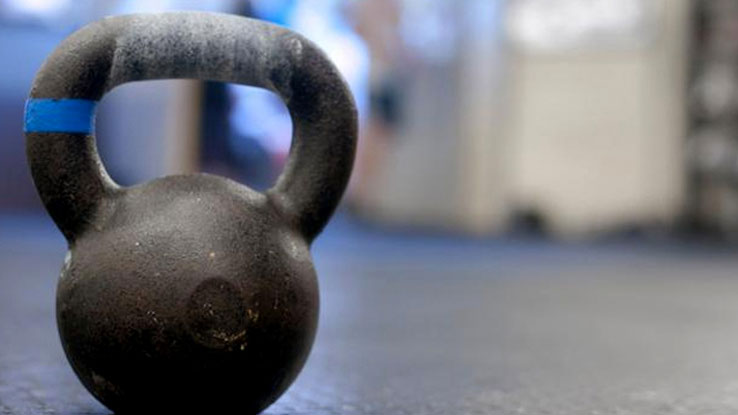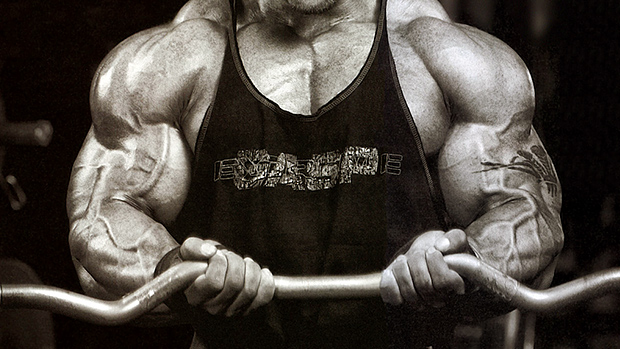Call me a sadistic SOB because I'm always glad to bring more pain your way. This time the red glow of my laser sight is dancing around your chest and I'm ready to pull the trigger.
This freshly unwrapped chest program takes a holistic approach that focuses on developing several physical capacities at the same time. If you've been stuck at the same level of pectoral development for what seems like forever, this program, which will be a drastic change of pace, is sure to spark some new growth ASAP.
The Framework
The program is based on several types of exercises:
Heavy lifting: Simply put, I've yet to see someone with a Kate Moss-like chest bench 400 pounds raw. While strength isn't always linearly correlated with size, getting stronger is sure to help you pack on slabs of beef.
High rep work: While the amount of tension produced by the contraction of the muscle (more force being produced = more tension) is a determining factor in stimulating growth, time under tension (the length of time that a muscle stays contracted during a set) is also very important in making your muscles bigger.
Work done in the time under tension (TUT) zone of 40 to 60 seconds is very effective at making your muscles grow like weeds.
Unstable training: Yeah, I know what you're thinking: Unstable training is for dorks. Sure, overused and wrongfully applied unstable training is for dorks, but if used in moderation and for a specific purpose (which we'll see in a moment) it can be useful.
The following is from my book, High-Threshold Muscle Building:
Another controversial topic when it comes to building muscle is the use of unstable exercises; movements performed where the base of support is unstable would theoretically have the potential to increase muscle activation in an attempt to achieve proper joint and movement stability (Lehman et al. 2006).
So, in theory, it would seem that unstable training could increase muscle activation due to an increased demand on the neuromuscular system in order to stabilize the articulation joints rendered unstable by the surface used as a base of support. Still, in theory, that could mean that unstable exercise could improve the capacity of the nervous system to activate certain muscles.
Performing a push-up movement with the hands on a Swiss ball increases triceps activation significantly compared to a regular push-up (22% activation for stable, 43% for unstable). Changes in pectoral activation were positive with the unstable push-up, but didn't reach statistical significance (21% activation for stable, 26.6% for unstable). This still shows a tendency towards greater activation of the pectorals with this exercise (Lehman et al. 2006).
However, when the push-ups were performed with the feet on the ball instead of the hands, there was no difference in muscle activation. This would seem to indicate that to increase upper body muscle activation the unstable surface should be under the hands and not the feet. It would also seem that the closer a muscle is to the source of instability, the more activation potentiation there is, while muscles far away from the source of instability aren't affected as much.

It's even more awful than you previously thought.
However, an argument against the use of unstable movements is that force production during these exercises is lower compared to similar exercises performed on a stable surface (Anderson and Behm, 2001). As we saw earlier, force production is one of the most important factors governing the recruitment of the HTMUs. So it's possible that a technique leading to lesser force production could decrease the efficiency of an exercise.
Unstable training has been widely used for rehabilitation and injury prevention purposes with a considerable amount of success. Naughton et al. (2005) found unstable upper body exercise effective at improving proprioception at the shoulder joint. However, the application of this type of training isn't well understood when it comes to mass building purposes.
There seems to be two distinct camps in the regard to unstable exercises utilization: those who do almost everything on an unstable surface and those who never use this method. Very few are in the middle, and even fewer make a logical utilisation of this technique.
Okay, back to our article!
I'll be clear right away: Unstable strength exercise can't and won't lead to the stimulation of as much muscle growth as stable variations of the movements. The decrease in force production will prevent maximum motor unit recruitment. As a result, using unstable variations of weightlifting exercise makes very little sense.
The main use of unstable training is to increase CNS activity; to "wake up" the nervous system, so to speak. The nervous system will have to work harder to maintain proper stability during the movement. So, when you perform an unstable movement, it potentiates the CNS, leading to greater motor unit activation during the subsequent lifting drills.
As such, it should be performed before a stable exercise with the same movement structure or muscle involvement (e.g. push-ups with the hands on a Swiss ball before moving on to dumbbell bench press).
This can be done as a superset (one set of an unstable exercise, no rest, one set of a stable exercise), in an alternate fashion (one set of an unstable exercise, brief rest period, one set of a stable exercise), or as a separate drill within a workout.
In the later case, the unstable exercise should be used at the beginning of the workout. However, the best options for maximum muscle growth are to either superset or alternate both types of exercises.
Maximum muscle tension exercises: When doing isolation exercises, the goal should be to maximize the amount of work actually being performed by the muscle.
Force can be produced by three factors:
1. The actual contraction of the muscle
2. The stretch reflex
3. The elastic component of the muscle and tendon
To maximize muscle tension, we must minimize the contribution of the stretch reflex and the elastic component of the muscle. As we saw last week, lifts from the floor do this nicely.
The stretch reflex is activated when there's a rapid change in the length of the muscle. When you're starting with the dumbbells on the floor, even if the muscle is stretched, there's no rapid change in length (you're starting from a static position), so the muscle must contract harder to lift the load.
The Holistic Chest Blast Program
A1) Main pressing exercise
Week 1: Bench press (medium grip)
7/5/3/7/5/3

Week 2: Floor press
6/4/2/6/4/2

Week 3: Bench press (medium grip)
5/3/1/5/3/1
Week 4: Bench press (wide grip)
10/10/8/8
Take 90 to 120 seconds of rest between A1 and A2.
Note: The remaining exercises are static; that is, they're to be performed as described throughout the program. The first exercise – the bench press – is the only one where the rep scheme varies.
A2) Pull-ups
4-6 reps

Add weight if you can do more than 6 reps; do negative reps if you're stuck below 4.
In this program, the pull-up isn't used to build the back, and it certainly doesn't count as a back training session. Rather, the objective is to take advantage of antagonistic training because alternating two antagonist exercises increases the strength of the first.
Take 45 to 60 seconds of rest between A2 and A3.
A3) Upper back stretch
30-45 seconds

The goal of the stretch is to inhibit the back muscles. Static stretching reduces the force capacity of a muscle, and reducing the strength of the back will facilitate the action of the pressing muscles when you get back to A1.
After A3, take 90 to 120 seconds of rest before returning to A1.
B) Multi-angle dumbbell press
4 x 8-10/max/max
75-90 seconds rest
Perform 8 to 10 reps of the high-incline dumbbell press. Don't take any rest, and lower the bench to a low incline and perform as many reps as you can with the same weight. Again, without any rest, lower the bench to the flat position, and continue to perform as many reps as you can with the same weight.
C1) Blast strap push-ups
3 x max reps
30 seconds rest

C2) Swiss ball push-ups
3 x max reps
30 seconds rest

C3) Push-ups
3 x max reps
120 seconds rest

Note: You can use push-up stands to decrease wrist pain.
D1) Blast strap flies
3 x max reps
No rest

D2) Floor flies
3 x 8-10 reps
90-120 seconds rest

Huge and Hurtin'
Give this program a try if you've been stuck in a canyon-sized rut for a while. Soreness and growth guaranteed!

